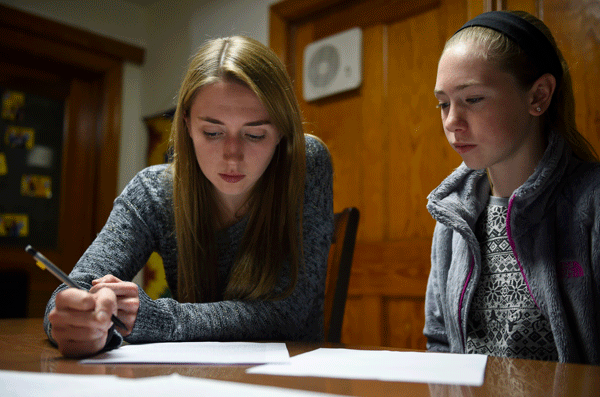Many Parents Don’t Know How Kids Are Doing in School: 9 Insights into Pandemic Recovery & Aftermath
A curated roundup of headlines about how the pandemic is shaping schools and education policy, vetted by AEI Visiting Fellow John Bailey.

Get stories like these delivered straight to your inbox. Sign up for The 74 Newsletter
This is our biweekly briefing on the pandemic, vetted by John Bailey. See the full archive.
This Week’s Top Story
Many American Parents Have No Idea How Their Kids Are Doing in School
- Via Time: “Many American parents would be shocked to know where their kids were actually achieving. Nationally, 90% of parents think their children are reading and doing math at or above grade level. In fact, 26% of eighth graders are proficient or above in math and 31% are proficient or above in English, according to Learning Heroes, an organization that collects data and creates resources to improve parent-teacher relationships.”
- “There are two reasons for the staggering mismatch between what teachers know and what parents think. The first is that many report cards do not measure just achievement, or what a child knows, but a basket of items including attendance, effort, homework completion and behavior.”
- “The second reason parents are in the dark about their children’s performance is that teachers are neither trained nor given ample time to have honest conversations with them. They rightly fear that they will be blamed, not believed, or not supported by their principals if they tell parents exactly where their children are performing.”

Key Insights
New COVID-19 Variant Emerges: BA.2.86 (Pirola)
- Wall Street Journal: “What’s troubling about this variant, scientists say, is that it contains more than 30 mutations on the spike protein, which is what helps the virus enter cells and cause an infection. This means it might be able to evade current vaccines and previous infections more easily, and it likely won’t be a great match with the fall booster expected to be approved soon.”
- “What’s unknown is how transmissible the variant is and whether it will spread widely or fizzle out like many other variants. Another important, outstanding question is whether it causes more severe disease.”
- “In a risk assessment released Aug. 23, the CDC said scientists are evaluating the effectiveness of the fall COVID-19 booster, expected to roll out in September, and the new variant.”
- More via Eric Topol.
Schools Got $190 Billion in Pandemic Aid, But the Funds Haven’t Reversed Learning Loss
- Via CNN: “If students can’t catch up, the learning loss may impact their future earnings and even become a drag on the U.S. economy.”
- ” ‘I hate to be so doom and gloom about it,’ said Robin Lake, director of the Center on Reinventing Public Education, a nonpartisan research and policy analysis organization. ‘But this is very serious. It’s an all-hands-on-deck moment for kids affected by COVID.’ ”
- “First, school districts did not use all of their funds to address learning loss specifically.”
- “Also, reversing the learning loss is easier said than done. Some school districts are facing a variety of challenges including staff shortages. And many school leaders say that political polarization around LGBTQ+ issues, critical race theory and COVID-19 has disrupted schooling, according to a report from the Center on Reinventing Public Education and RAND.”
Signs a District Will Be at Risk When ESSER Runs Out
- EdWeek on new reports from Education Resource Strategies and EdTrust.
- The report from Education Resource Strategies identifies risk factors that indicate the likely severity of a district’s post-ESSER fiscal situation:
- Districts that saw an enormous leap in per-pupil revenue likely faced more hurdles to spending that money quickly and wisely than districts that got only a small sum per student.
- Districts that invested federal relief funds in recurring expenses like increased teacher salaries or new staff positions will have to find new funding sources to cover those investments or risk needing to cut them.
- Districts seeing increases in state aid or local tax revenue will have an easier time filling ESSER-shaped budget holes than districts in states that have kept education funding flat amid high inflation.
- Some states and localities allow districts to maintain funding reserves from state and local sources that they can use for emergency situations, like the sudden loss of federal relief aid. Those districts have a financial cushion that their counterparts in states that restrict how districts can spend excess money won’t have.
- Districts that have been slow to invest their ESSER allocations could be tempted to hastily allocate funds to recurring or unwise expenses that come back to haunt them.

Why — and How — Leaders Should Fund Long-Term Tutoring
- New report from Accelerate: “Policymakers should pursue opportunities to allocate additional funding toward in-school day, high-impact tutoring, in time for the 2025 fiscal year. In tandem, policymakers could streamline policies to provide clarity and guidance for local system and school leaders’ use of federal funding.”
- “State and district system leaders should consider carry-forward dollars in federal funding streams that may have grown with the availability of ESSER. Tutoring programs could be further prioritized by using state and district set-asides across these funding streams.”
- “School leaders should use their Title I allocations to support their students’ learning needs by leveraging tutoring as an evidence-based intervention.”
Teacher Shortages Have Gotten Worse. Here’s How Schools Are Coping
- The Washington Post reports on a new analysis
- “Teachers are leaving the classroom at higher rates, and the pool of candidates is not big enough to replace them.”
- “Tuan Nguyen, a Kansas State University education professor, last year set out with two colleagues to collect statewide data on teacher shortages. They counted more than 36,500 vacancies in 37 states and D.C. for the 2021-22 school year. Updated data found that teacher shortages had grown 35% among that group, to more than 49,000 vacancies.”
Gen Z’s Declining College Interest Persists — Even Among Middle Schoolers
- The 74 on a new YPulse report
- “Two in five Gen Z students agreed with the statement: ‘The pandemic has made me less interested in pursuing higher education.’ ”
- “That attitude has translated into an 8% decline in college enrollment from 2019 to 2022, showing how attending college is no longer a given for Gen Z.”
- “YPulse found Gen Z students were more likely to choose Google and YouTube over a teacher when asked: ‘If you wanted to learn something new, what resources would you use?’ ”
Fueled by Teacher Shortages, ‘Zoom-in-a-Room’ Makes a Comeback
- Via The 74: “Live, online instruction in school has long linked students to subjects they couldn’t otherwise take, like A.P. Calculus or Latin. But as districts struggle to fill teaching vacancies, they are increasingly turning to companies like Proximity to teach core subjects.”
- “Districts are spending thousands, sometimes millions, of dollars on virtual teachers, according to The 74’s review of purchase orders. … The practice — derided at the height of the pandemic as “Zoom-in-a-room” — is raising eyebrows as students return to school and continue to grapple with the lingering effects of remote learning.”
How Schools Can Survive (and Maybe Even Thrive) With A.I. This Fall
- Via The New York Times: “Step 1: Assume all students are going to use the technology.”
- “There is a lot of confusion and panic, but also a fair bit of curiosity and excitement. Mainly, educators want to know: How do we actually use this stuff to help students learn, rather than just try to catch them cheating?”
- “Second, schools should stop relying on A.I. detector programs to catch cheaters.”
- “My third piece of advice … is that teachers should focus less on warning students about the shortcomings of generative A.I. than on figuring out what the technology does well.”
- “My last piece of advice for schools that are flummoxed by generative A.I. is this: Treat this year — the first full academic year of the post-ChatGPT era — as a learning experience, and don’t expect to get everything right.”
…On a Lighter Note
WIIIII: One way to keep Zooms interesting.
Bear Cubs: Trying to get on a hammock.
Disclosure: John Bailey is an adviser to the Walton Family Foundation, which provides financial support to The 74.
Get stories like these delivered straight to your inbox. Sign up for The 74 Newsletter


